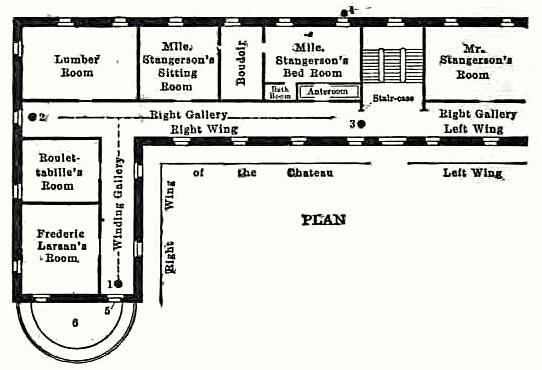Saying which the young reporter invited me to go and make the tour of the chateau with him. The only sound to be heard was the crunching of the dead leaves beneath our feet. The silence was so intense that one might have thought the chateau had been abandoned. The old stones, the stagnant water of the ditch surrounding the donjon, the bleak ground strewn with the dead leaves, the dark, skeleton-like outlines of the trees, all contributed to give to the desolate place, now filled with its awful mystery, a most funereal aspect. As we passed round the donjon, we met the Green Man, the forest-keeper, who did not greet us, but walked by as if we had not existed. He was looking just as I had formerly seen him through the window of the Donjon Inn. He had still his fowling-piece slung at his back, his pipe was in his mouth, and his eye-glasses on his nose.
“An odd kind of fish!” Rouletabille said to me, in a low tone.
“Have you spoken to him?” I asked.
“Yes, but I could get nothing out of him. His only answers are grunts and shrugs of the shoulders. He generally lives on the first floor of the donjon, a big room that once served for an oratory. He lives like a bear, never goes out without his gun, and is only pleasant with the girls. The women, for twelve miles round, are all setting their caps for him. For the present, he is paying attention to Madame Mathieu, whose husband is keeping a lynx eye upon her in consequence.”
After passing the donjon, which is situated at the extreme end of the left wing, we went to the back of the chateau. Rouletabille, pointing to a window which I recognised as the only one belonging to Mademoiselle Stangerson’s apartment, said to me:
“If you had been here, two nights ago, you would have seen your humble servant at the top of a ladder, about to enter the chateau by that window.”
As I expressed some surprise at this piece of nocturnal gymnastics, he begged me to notice carefully the exterior disposition of the chateau. We then went back into the building.
“I must now show you the first floor of the chateau, where I am living,” said my friend.
To enable the reader the better to understand the disposition of these parts of the dwelling, I annex a plan of the first floor of the right wing, drawn by Rouletabille the day after the extraordinary phenomenon occurred, the details of which I am about to relate.

Rouletabille motioned me to follow him up a magnificent flight of stairs ending in a landing on the first floor. From this landing one could pass to the right or left wing of the chateau by a gallery opening from it. This gallery, high and wide, extended along the whole length of the building and was lit from the front of the chateau facing the north. The rooms, the windows of which looked to the south, opened out of the gallery. Professor Stangerson inhabited the left wing of the building. Mademoiselle Stangerson had her apartment in the right wing.
We entered the gallery to the right. A narrow carpet, laid on the waxed oaken floor, which shone like glass, deadened the sound of our footsteps. Rouletabille asked me, in a low tone, to walk carefully, as we were passing the door of Mademoiselle Stangerson’s apartment. This consisted of a bed-room, an ante-room, a small bath-room, a boudoir, and a drawing-room. One could pass from one to another of these rooms without having to go by way of the gallery. The gallery continued straight to the western end of the building, where it was lit by a high window (window 2 on the plan). At about two-thirds of its length this gallery, at a right angle, joined another gallery following the course of the right wing.
The better to follow this narrative, we shall call the gallery leading from the stairs to the eastern window, the “right” gallery and the gallery quitting it at a right angle, the “off-turning” gallery (winding gallery in the plan). It was at the meeting point of the two galleries that Rouletabille had his chamber, adjoining that of Frederic Larsan, the door of each opening on to the “off-turning” gallery, while the doors of Mademoiselle Stangerson’s apartment opened into the “right” gallery. (See the plan.)
Rouletabille opened the door of his room and after we had passed in, carefully drew the bolt. I had not had time to glance round the place in which he had been installed, when he uttered a cry of surprise and pointed to a pair of eye-glasses on a side-table.
“What are these doing here?” he asked.
I should have been puzzled to answer him.
“I wonder,” he said, “I wonder if this is what I have been searching for. I wonder if these are the eye-glasses from the presbytery!”
He seized them eagerly, his fingers caressing the glass. Then looking at me, with an expression of terror on his face, he murmured, “Oh!—Oh!”
He repeated the exclamation again and again, as if his thoughts had suddenly turned his brain.
He rose and, p............
